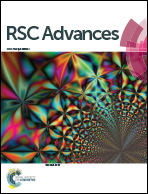Metal catalyst free one-pot synthesis of 2-arylbenzimidazoles from α-aroylketene dithioacetals†
Abstract
An efficient green synthetic approach has been developed towards the synthesis of 2-aryl substituted benzimidazoles from α-aroylketene dithioacetals (AKDTAs) 1 and o-phenylenediamine (OPD) 2. The reaction has been achieved in water with a catalytic amount of acetic acid. 2-Arylbenzimidazoles have been synthesized in remarkable yields under both thermal and microwave conditions. The metal catalyst free condition makes this transformation very green, practical and attractive.


 Please wait while we load your content...
Please wait while we load your content...